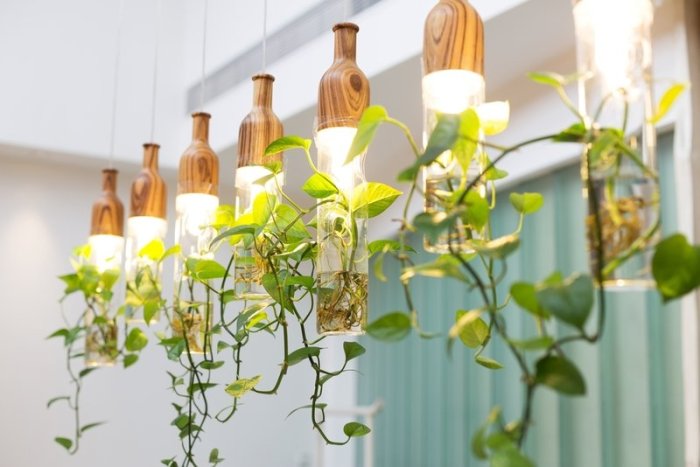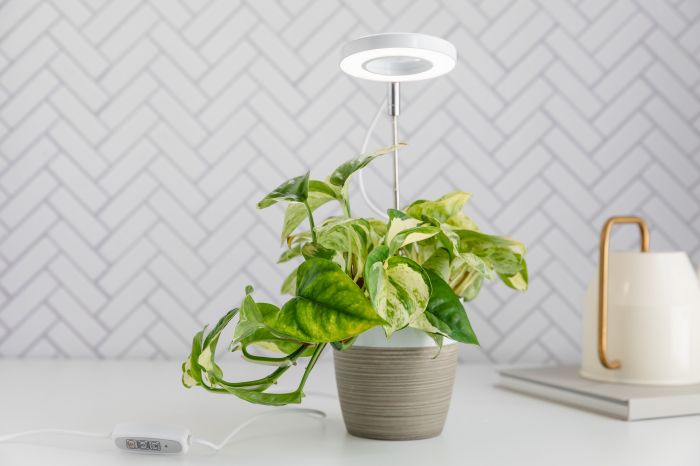Hanging plants with lights is a beautiful and practical way to add life and style to your home. With the right combination of plants and lighting, you can create a lush indoor oasis that will thrive for years to come.
In this guide, we will discuss the best plants for hanging baskets, the optimal light intensity and color temperature for different plant varieties, and how to determine the ideal placement of hanging plants relative to light sources. We will also provide tips on selecting plant species and light combinations that create visually appealing arrangements, and discuss the use of color theory and complementary lighting to enhance the overall aesthetic impact.
Hanging Plants and Lighting Combinations
Suspending plants from ceilings or walls using hanging baskets has become a popular trend, adding a touch of greenery and vertical interest to indoor spaces. However, choosing the right plant species and providing adequate lighting are crucial for the success of these hanging gardens.
Suitable Plant Species
Not all plant species are well-suited for hanging baskets under artificial light. Ideal choices include:
- Pothos (Epipremnum aureum): Known for its trailing vines and tolerance for low light conditions.
- Spider Plant (Chlorophytum comosum): Produces long, arching leaves and tolerates a range of light intensities.
- Peace Lily (Spathiphyllum wallisii): Features lush, dark green leaves and prefers indirect light.
- ZZ Plant (Zamioculcas zamiifolia): Known for its drought tolerance and ability to thrive in low light conditions.
- String of Pearls (Senecio rowleyanus): Features delicate, bead-like foliage and prefers bright, indirect light.
Optimal Light Requirements
The optimal light intensity, color temperature, and duration vary depending on the plant species. In general:
- Light Intensity:Most hanging plants require moderate to bright indirect light. Avoid placing them directly under strong light sources, as this can scorch their leaves.
- Color Temperature:Full-spectrum LED grow lights with a color temperature of 5,000-6,500 Kelvin (K) provide the best light quality for most plants.
- Duration:Hanging plants generally require 12-16 hours of light per day. Use timers to ensure consistent lighting.
Placement, Hanging plants with lights
The ideal placement of hanging plants relative to light sources depends on the plant’s light requirements. Plants that prefer bright light should be placed closer to the light source, while those that tolerate low light can be placed further away.
Consider using adjustable hanging systems or plant hooks that allow you to move the plants closer or further from the light source as needed.
Aesthetic Considerations for Hanging Plants with Lights
Hanging plants with lights can elevate the aesthetics of any space, creating a harmonious blend of nature and illumination. To achieve a visually stunning arrangement, it’s crucial to consider the styles, designs, and combinations of hanging planters and lighting fixtures.
Style and Design
The style and design of hanging planters should complement the lighting fixtures to create a cohesive look. For modern interiors, sleek and geometric planters paired with minimalist lighting fixtures enhance the clean lines and sharp angles. In rustic or bohemian settings, woven or macrame planters complement vintage-style fixtures, adding warmth and texture to the space.
Plant and Light Combinations
Selecting the right plant species and light combinations is essential for visual appeal. Plants with trailing or cascading foliage, such as pothos or spider plants, look stunning in hanging planters with downward-facing lights. Conversely, upright plants like succulents or air plants thrive under overhead or diffused lighting from fixtures positioned above them.
Color Theory and Complementary Lighting
Color theory plays a vital role in enhancing the overall aesthetic impact. Consider the color of the hanging planter and the plant’s foliage when choosing the lighting fixture. Complementary colors, such as blue and orange or green and red, create a visually striking contrast.
Warm lighting, such as incandescent or LED bulbs, complements plants with lush green foliage, while cooler lighting, such as fluorescent or LED bulbs, emphasizes the vibrant colors of variegated plants.
Practical Considerations for Hanging Plants with Lights

When utilizing artificial lighting for hanging plants, meticulous plant maintenance practices are paramount. Regular watering, appropriate fertilization, and judicious pruning ensure optimal plant health and prevent growth issues. Proper watering schedules depend on the plant species, light intensity, and environmental conditions.
Overwatering should be avoided, as it can lead to root rot and other problems.
Potential Safety Hazards
Hanging plants in proximity to electrical fixtures poses potential safety hazards. To mitigate risks, ensure adequate clearance between plants and light sources to prevent overheating and potential fire hazards. Additionally, avoid placing plants directly beneath light fixtures, as this can block airflow and cause heat buildup.
Energy-Efficient Lighting Options
To optimize plant growth while minimizing energy consumption, consider energy-efficient lighting options. LED grow lights are highly efficient, producing minimal heat and consuming less energy compared to traditional incandescent or fluorescent bulbs. By choosing energy-efficient lighting, you can reduce your carbon footprint and save on electricity costs.
Creating a Green Oasis with Hanging Plants and Lights

Incorporating hanging plants with artificial lighting into indoor spaces offers a myriad of benefits, transforming them into serene and inviting havens. This fusion of greenery and illumination not only enhances the aesthetics but also promotes psychological well-being, creating a harmonious and rejuvenating environment.
paragraphStudies have shown that exposure to plants and natural light can reduce stress, improve mood, and enhance cognitive function. By combining these elements through hanging plants with lights, individuals can reap the benefits of both, fostering a sense of tranquility and vitality within their living spaces.
Hanging plants with lights can be a great way to add some greenery to your home. But if you don’t have a lot of natural light, you may want to consider hanging plants near a window instead. This will give your plants the light they need to thrive.
For more information on hanging plants near windows, visit hanging plants near window . You can also use grow lights to supplement the natural light your plants receive. This will help them to grow healthy and strong, even in low-light conditions.
Hanging plants with lights can be a beautiful and easy way to add some life to your home.
Enhancing Specific Areas
Hanging plants with lights can be strategically placed to accentuate and enhance specific areas of the home:
-
-*Living rooms
Cascading greenery from hanging planters adds a touch of elegance and warmth to living rooms, creating a cozy and inviting ambiance.
-*Bedrooms
Soft, diffused lighting from hanging plants promotes relaxation and tranquility, fostering a restful and serene sleep environment.
-*Home offices
Hanging plants with lights can add a touch of greenery and ambiance to any outdoor space. If you’re looking for a wide variety of options, be sure to check out the bunnings outdoor hanging plants collection. They have a great selection of plants that are perfect for hanging, as well as all the supplies you need to get started.
Hanging plants with lights are a great way to add a touch of nature to your outdoor space, and they’re also a great way to add some extra light to your evenings.
Hanging plants with bright, focused lighting can boost productivity and creativity, providing a stimulating and invigorating workspace.
DIY Projects and Ideas for Hanging Plants with Lights

Transform your home into a verdant oasis with DIY hanging plant projects that seamlessly integrate lighting. Embrace creativity by crafting custom planters using repurposed materials and incorporating smart lighting technology to automate plant care and create captivating lighting effects.
For those seeking to brighten up their homes with hanging plants, selecting the right species that thrive under full sun is crucial. Refer to our guide on which hanging plants like full sun for recommendations on varieties that will flourish in sunny conditions.
By choosing the appropriate plants and providing adequate lighting, you can create a vibrant and lush indoor oasis.
Creating Custom Hanging Planters
Unleash your inner designer and create unique hanging planters using everyday objects. Upcycle wooden crates, repurpose baskets, or transform glass jars into stylish plant holders. Securely attach them to the ceiling or walls using chains, ropes, or macrame cords, adding a touch of bohemian charm to your space.
Repurposing Everyday Objects
Breathe new life into old items by transforming them into functional plant hangers. Utilize empty cans, plastic bottles, or even old light bulbs to create whimsical and sustainable plant displays. With a little creativity, these repurposed objects can become eye-catching focal points in your home.
Incorporating Smart Lighting Technology
Elevate your hanging plants with smart lighting technology. Integrate LED grow lights to provide optimal lighting for plant growth, even in low-light conditions. Automate watering schedules and monitor soil moisture levels using smart sensors, ensuring your plants thrive without constant attention.
Creating Dynamic Lighting Effects
Harness the power of smart lighting to create dynamic lighting effects that enhance the beauty of your hanging plants. Experiment with color-changing LEDs to create a vibrant ambiance or use programmable lighting sequences to simulate natural sunlight patterns, fostering healthy plant growth.
Last Point

Hanging plants with lights is a great way to add beauty and functionality to your home. With a little planning and care, you can create a thriving indoor garden that will bring you joy for years to come.
Quick FAQs: Hanging Plants With Lights
What are the best plants for hanging baskets?
Some of the best plants for hanging baskets include pothos, spider plants, philodendrons, and ferns. These plants are all relatively easy to care for and can tolerate a wide range of light conditions.
What is the optimal light intensity and color temperature for different plant varieties?
The optimal light intensity and color temperature for different plant varieties will vary. However, as a general rule of thumb, most plants will do well under bright, indirect light. If you are unsure about the specific light requirements of your plant, it is always best to consult with a plant care expert.
How do I determine the ideal placement of hanging plants relative to light sources?
The ideal placement of hanging plants relative to light sources will depend on the specific plant variety. However, as a general rule of thumb, most plants will do well when they are placed within a few feet of a window.
If you are unsure about the specific light requirements of your plant, it is always best to consult with a plant care expert.